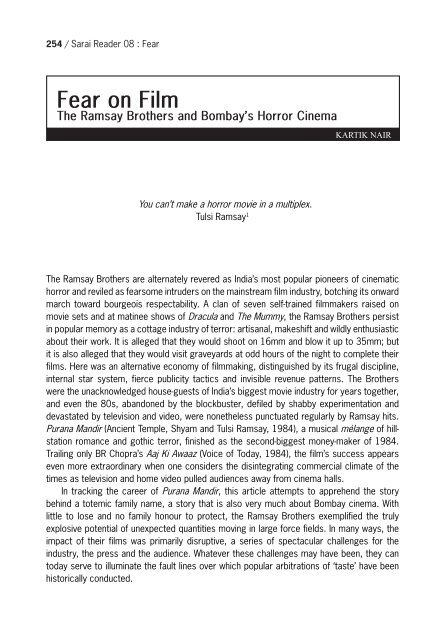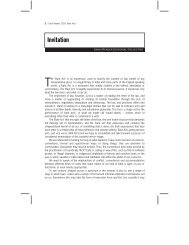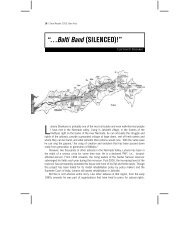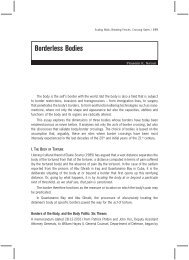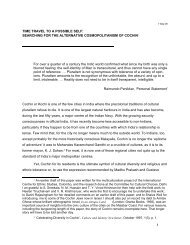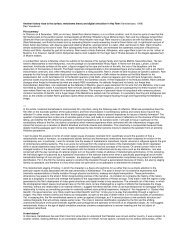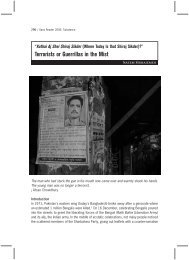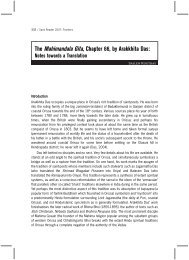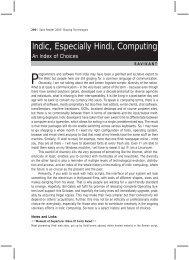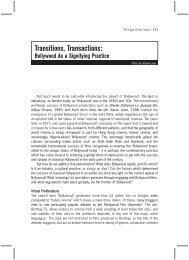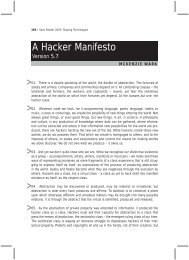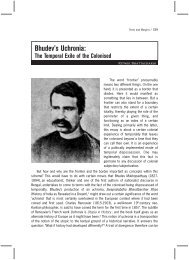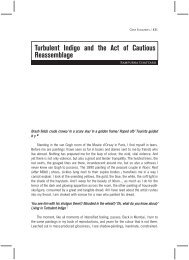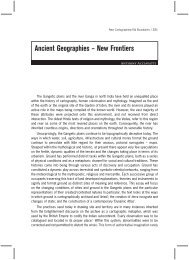Create successful ePaper yourself
Turn your PDF publications into a flip-book with our unique Google optimized e-Paper software.
254 / <strong>Sarai</strong> Reader 08 : <str<strong>on</strong>g>Fear</str<strong>on</strong>g><br />
<str<strong>on</strong>g>Fear</str<strong>on</strong>g> <strong>on</strong> <strong>Film</strong><br />
The Ramsay Brothers and Bombay’s Horror Cinema<br />
You can’t make a horror movie in a multiplex.<br />
Tulsi Ramsay 1<br />
KARTIK NAIR<br />
The Ramsay Brothers are alternately revered as India’s most popular pi<strong>on</strong>eers of cinematic<br />
horror and reviled as fearsome intruders <strong>on</strong> the mainstream film industry, botching its <strong>on</strong>ward<br />
march toward bourgeois respectability. A clan of seven self-trained filmmakers raised <strong>on</strong><br />
movie sets and at matinee shows of Dracula and The Mummy, the Ramsay Brothers persist<br />
in popular memory as a cottage industry of terror: artisanal, makeshift and wildly enthusiastic<br />
about their work. It is alleged that they would shoot <strong>on</strong> 16mm and blow it up to 35mm; but<br />
it is also alleged that they would visit graveyards at odd hours of the night to complete their<br />
films. Here was an alternative ec<strong>on</strong>omy of filmmaking, distinguished by its frugal discipline,<br />
internal star system, fierce publicity tactics and invisible revenue patterns. The Brothers<br />
were the unacknowledged house-guests of India’s biggest movie industry for years together,<br />
and even the 80s, aband<strong>on</strong>ed by the blockbuster, defiled by shabby experimentati<strong>on</strong> and<br />
devastated by televisi<strong>on</strong> and video, were n<strong>on</strong>etheless punctuated regularly by Ramsay hits.<br />
Purana Mandir (Ancient Temple, Shyam and Tulsi Ramsay, 1984), a musical mélange of hillstati<strong>on</strong><br />
romance and gothic terror, finished as the sec<strong>on</strong>d-biggest m<strong>on</strong>ey-maker of 1984.<br />
Trailing <strong>on</strong>ly BR Chopra’s Aaj Ki Awaaz (Voice of Today, 1984), the film’s success appears<br />
even more extraordinary when <strong>on</strong>e c<strong>on</strong>siders the disintegrating commercial climate of the<br />
times as televisi<strong>on</strong> and home video pulled audiences away from cinema halls.<br />
In tracking the career of Purana Mandir, this article attempts to apprehend the story<br />
behind a totemic family name, a story that is also very much about Bombay cinema. With<br />
little to lose and no family h<strong>on</strong>our to protect, the Ramsay Brothers exemplified the truly<br />
explosive potential of unexpected quantities moving in large force fields. In many ways, the<br />
impact of their films was primarily disruptive, a series of spectacular challenges for the<br />
industry, the press and the audience. Whatever these challenges may have been, they can<br />
today serve to illuminate the fault lines over which popular arbitrati<strong>on</strong>s of ‘taste’ have been<br />
historically c<strong>on</strong>ducted.
Scared <strong>on</strong> Screen / 255<br />
The Family Enterprise<br />
After years of apprenticeship, the s<strong>on</strong>s of small-time film producer FU Ramsay persuade the<br />
patriarch to finance an all-out horror film. The result: Do Gaz Zameen Ke Neechey (Beneath Two<br />
Yards of Earth, Shyam and Tulsi Ramsay, 1972), a breakout hit that sets the style for Ramsay<br />
producti<strong>on</strong>s to come. Every few m<strong>on</strong>ths over the next two decades, cast and crew alike would<br />
be packed into buses and transported to the outskirts of Bombay for filming. Here, brothers<br />
Shyam and Tulsi Ramsay would dispatch directorial duties; brother Kumar would write the<br />
scenes while brother Gangu would lens them; Kiran Ramsay was usually in charge of sound<br />
and Arjun in charge of producti<strong>on</strong>; meanwhile, Mother Ramsay would cook for every<strong>on</strong>e. 2<br />
Since the executi<strong>on</strong> of the horror genre is painstaking, and its funds limited, it is no surprise<br />
that the Ramsay Brothers never worked with b<strong>on</strong>a fide stars. Instead, trending with much of<br />
horror across film cultures, they relied <strong>on</strong> fresh, young blood to lubricate their producti<strong>on</strong>s: the<br />
appeal of quick m<strong>on</strong>ey without the hassles of high-maintenance stars. Usually attractive, these<br />
young men and women were required to keep pace with the Ramsays; often, they became<br />
niche stars, returning to work with the family again in roles <strong>on</strong>ly superficially distinguished from<br />
<strong>on</strong>e another. A case in point is Arti Gupta, a model who had dabbled in film work previously but<br />
made the decisive transiti<strong>on</strong> <strong>on</strong>ly when she was cast in the lead for Purana Mandir. After its<br />
success, she became a darling to the Brothers, their very own ‘scream queen’.<br />
Produced <strong>on</strong> express schedules and shoestring budgets, the Brothers’ titles would then<br />
be released <strong>on</strong> a dozen prints in Bombay’s less-favoured theatres. By the sec<strong>on</strong>d week, that<br />
number would drop to ten; by the third week, <strong>on</strong>ly a print or two would remain in circulati<strong>on</strong> in<br />
the city. By this time, a Ramsay film would have begun its journey into the interiors, playing <strong>on</strong><br />
<strong>on</strong>e screen in Pune in its fourth week, and <strong>on</strong> <strong>on</strong>e in Wai in its seventh. 3 Trade wisdom suggests<br />
the Ramsays did 60 percent of their business in rural territories, where returns are slower<br />
and smaller and clouded with administrative haziness. 4 Numbers in <strong>Film</strong> Informati<strong>on</strong>, despite<br />
its meticulousness, represent <strong>on</strong>ly the tip of the box-office iceberg since the journal does not<br />
record revenues from the less-prestigious ‘B’ and ‘C’ centres, each with their own (tax) evasive<br />
histories. There is the additi<strong>on</strong>al problem of the journal’s veracity, thrown into questi<strong>on</strong> by Tulsi<br />
Ramsay’s unexpected and somewhat enigmatic comment midway through an interview: “We<br />
were always after <strong>Film</strong> Informati<strong>on</strong>. Report should come good, should come good”. 5<br />
The relative persistence of this business model enhanced the bewildering opacity around<br />
the family enterprise. Their movies, caught in the divide between the respectable and the ridiculous,<br />
the legal and the illegal, often had truly c<strong>on</strong>founding commercial lives. In an article titled<br />
“The Paradoxical Situati<strong>on</strong>”, VP Sathe noted his amazement at the fact that “a n<strong>on</strong>-star cast<br />
horror adult film like Purana Mandir has been released in as many as twenty-three theatres”,<br />
c<strong>on</strong>tinuing that “at most of the theatres, the picture drew full houses” (Sathe, 1984). <strong>Film</strong><br />
Informati<strong>on</strong> tells us Purana Mandir was in fact diverted to the black market during the very first<br />
week of its release. “Video cassettes of Purana Mandir which was being shown to about 75<br />
pers<strong>on</strong>s was seized from the parlour”, reads a report <strong>on</strong> a police raid in Bombay. “The police<br />
also seized a Nelco VCR, West<strong>on</strong> TV and Rs 105 in cash” (<strong>Film</strong> Informati<strong>on</strong>, 1984).
256 / <strong>Sarai</strong> Reader 08 : <str<strong>on</strong>g>Fear</str<strong>on</strong>g><br />
<strong>Film</strong> piracy activates anxieties around legitimacy and public morality for texts entering<br />
popular circuits. Purana Mandir had already been certified an ‘adult’ film by the Central Board<br />
of <strong>Film</strong> Certificati<strong>on</strong>, so imagine the surprise of the police when they entered the parlour to<br />
find that “many children were seeing the film at the time of the raid” (<strong>Film</strong> Informati<strong>on</strong>, 1984).<br />
Worse than the scourge of copyright violati<strong>on</strong>, bootlegging promises to corrupt our young.<br />
The censors are out to save our families, and the pirates out to destroy them. Ramsay<br />
horror, with its ostensible stock-in-trade of sex and violence, was energised by the efforts of<br />
both cops and robbers. Simultaneously, bootlegging served its eternal purpose as a viable<br />
other, a mafia-run shadow ec<strong>on</strong>omy bey<strong>on</strong>d the law. A ficti<strong>on</strong> fed to sustain the myth of ‘good<br />
m<strong>on</strong>ey’, to discriminate between pirates and producers, this shadow ec<strong>on</strong>omy could make<br />
the meanest financiers – even the Ramsays – look like clean citizens.<br />
Watching Purana Mandir<br />
What happens: In the l<strong>on</strong>g-l<strong>on</strong>g-ago (200 years ago), the indefatigable m<strong>on</strong>ster Samri (Ajay<br />
Aggarwal) terrorises Bijapur, the sultanate of Raja Hariman Singh. Samri frequently disrobes<br />
“naujawaan, shaadi-shuda” (young, married) women, kills children and disinters corpses<br />
to eat them. When he attacks the Raja’s daughter, a royal decree is passed ordering his<br />
decapitati<strong>on</strong>. Before he is thus executed, the m<strong>on</strong>ster makes a vow to return to life <strong>on</strong>ce<br />
again and curses the King’s female heirs with horrible deaths in childbirth.<br />
Cut to the ‘present day’ and the city. The latest descendant in the line of the Raja is Thakur<br />
Ranbir Singh (Pradeep Kumar), whose <strong>on</strong>ly child is the attractive Suman (Arti Gupta), a<br />
lissome girl of college-going age. Suman is in love with the strapping Sanjay (Mohnish Behl),<br />
and the two can barely keep their hands off <strong>on</strong>e another, which sets alarm-bells ringing in the<br />
Thakur’s head. Not having forgotten the curse that will strike Suman should she have a child<br />
of her own, he tries to break the couple up. Failing, the distraught father reveals the shraap<br />
(curse) that has followed their family all the way down the centuries from Bijapur. C<strong>on</strong>vinced<br />
that the curse is nothing they can’t overcome, Sanjay and Suman leave the city to return<br />
to the haveli (mansi<strong>on</strong>) where it all began. Eventually, they overpower a back-from-the-dead<br />
Samri. The m<strong>on</strong>ster is burnt at the stake, the curse is lifted, and the lovers are married with<br />
the blessings of the Thakur.<br />
As a narrative device, the curse at the centre of Purana Mandir is utterly unexcepti<strong>on</strong>al (an<br />
obstacle is created and then overcome), but its provenance is fairly interesting, a particularly<br />
instructive instance of the Brothers’ ingenious deployment of horror film tropes. In countless<br />
American slasher films of the 70s and early 80s (Friday the 13th, Prom Night, Nightmare<br />
<strong>on</strong> Elm Street), sexual intercourse outside marriage is strictly prohibited, and trespassers<br />
invoke certain death at the hands of a knife/axe/machete/spear/impaling rod/electrocuting<br />
hotwire/scorching t<strong>on</strong>gs-wielding maniac. In each film, we witness the bodies of young<br />
men and women enjoying sex away from the surveillance of their parents in an unpoliced<br />
and semi-rural envir<strong>on</strong>ment where adolescent anarchy prevails. In each film, we witness the<br />
bodies of young men and women being yanked back under surveillance, ‘disciplined’ <strong>on</strong>ce<br />
again through torture. These grisly moments imbue the slasher film with the air of a parable
Scared <strong>on</strong> Screen / 257<br />
or cauti<strong>on</strong>ary tale to warn against teenage illicit sex, cinematically c<strong>on</strong>verting it into taboo<br />
via an experience of Ripper-like horror.<br />
Such repressive censoriousness means almost nothing in Bombay cinema, where it would<br />
be impossible to write a film in which teenagers are shown experiencing spectacular death,<br />
little or big. Graphic sex and fr<strong>on</strong>tal nudity are already taboo, anathema for an idiom which<br />
relegates them to a noti<strong>on</strong>al, invisible privacy somewhere bey<strong>on</strong>d the end credits. No knives<br />
or axes are needed to temper sexual appetite in Bombay; there is already a series of tacit<br />
codes in place to make sure no <strong>on</strong>e gets frisky. Instituti<strong>on</strong>alised censorship is <strong>on</strong>ly <strong>on</strong>e of<br />
these codes; c<strong>on</strong>sider equally the ever-present extended family, keeping a watchful eye within<br />
the diegetic world so that most unpoliced and parentless worlds remain dream locales.<br />
In Purana Mandir, therefore, the curse of death is activated with childbirth: as a definite<br />
c<strong>on</strong>sequence of sex but sex within sacred marriage – almost like a side-effect of legitimate,<br />
productive and m<strong>on</strong>itored sexuality. The shraap thus emerges in the rapprochement of fears<br />
– a kind of handshake in which both hands pocket something – serving as an instructive<br />
example of the way censorship doesn’t just happen to a pre-existing text; rather, it looms<br />
always <strong>on</strong> the creative horiz<strong>on</strong>, a<br />
phenomenal presence with instituti<strong>on</strong>al<br />
weight that challenges filmmakers<br />
in highly productive ways.<br />
Further, the shraap also functi<strong>on</strong>s<br />
within the dominant syntax<br />
of m<strong>on</strong>strosity/sexuality popularised<br />
in British Hammer films (The<br />
Brides of Dracula, 1960; The<br />
Curse of the Werewolf, 1961) and<br />
serves as the means whereby the<br />
urban is displaced in favour of the<br />
backwoods. After the fashi<strong>on</strong> of<br />
much horror from the American<br />
independent phase (especially The<br />
Texas Chainsaw Massacre, Tobe<br />
Hooper, 1974), this relocati<strong>on</strong><br />
provides the setting for a primitive<br />
ordeal from which a young<br />
woman, man or (as in the case<br />
of Purana Mandir) heterosexual<br />
couple escapes back to the order<br />
of the city. However, the exigencies<br />
of Bombay cinema require<br />
Suman’s father to be witness to<br />
Sanjay’s physical agency and
258 / <strong>Sarai</strong> Reader 08 : <str<strong>on</strong>g>Fear</str<strong>on</strong>g><br />
masculine prowess in subduing the m<strong>on</strong>ster and re-establishing harm<strong>on</strong>y where there was<br />
<strong>on</strong>ce chaos. Therefore, in an unprecedented move for a horror film, Purana Mandir ends not<br />
with the bruised dyad but with a happy trio: boy, girl and girl’s father. “I’m really proud of you,<br />
my s<strong>on</strong>”, the Thakur sniffs. The ‘Purana Mandir’ of horror literally modulates into the mandir<br />
(temple) of the marriage cerem<strong>on</strong>y as Sanjay and Suman are wed and ‘The End’ is hurriedly<br />
ushered in.<br />
Inescapable here is the clunkiness of the Ramsay Brothers who, with their limited budgets<br />
and talents, <strong>on</strong>ly occasi<strong>on</strong>ally realised their ambiti<strong>on</strong>s. The frenetic camera movement of<br />
some sequences in Purana Mandir bears resemblance to the innovative cinematography<br />
in Evil Dead (Sam Raimi, 1981); the baroque, taxidermically-inclined space of the haveli<br />
recalls The Haunting (Robert Wise, 1963) or any number of Hammer films; the extremely<br />
tight compositi<strong>on</strong> into which something (a cat, a crazy woman) suddenly emerges to scare<br />
the living daylights out of Suman suggests Halloween (John Carpenter, 1978); the coffin<br />
and horse-drawn carriage are straight out of numerous Stoker adaptati<strong>on</strong>s; there are pointof-view<br />
shots that are akin to shots from Black Christmas (Bob Clark, 1974), as well as the<br />
Romero-style gait of the possessed man-servant. For the most part, though, these moments<br />
of ‘horror’ play out as incompetent hack-jobs and incomplete masteries. Night-time shooting<br />
was still a problem for the Ramsays, and Purana Mandir would have additi<strong>on</strong>ally called for a<br />
fairly complex choreography of darkness and lighting, silence <strong>on</strong> set and post-sync sound,<br />
not to menti<strong>on</strong> a small army of technicians working with prosthetics, make-up, fog machines<br />
and other ‘special effects’. It remains unclear what degrees of expertise were involved, given<br />
the general sense of workshop-improvisati<strong>on</strong> prevailing with the family.<br />
Where, then, does the horror inhere in a Ramsay film? The genre’s c<strong>on</strong>venti<strong>on</strong>s, forced into<br />
visibility by the yawning gap between aspirati<strong>on</strong> and accomplishment – when the make-up<br />
is under-baked, or the camera doesn’t move nearly fast enough, or when the cat looks less<br />
like it’s jumping into the frame and more like it’s being chucked into it by a spotboy – can<br />
be moments of unintenti<strong>on</strong>al hilarity, as globally circulating ‘signs’ of horror are shriveled to<br />
an embarrassingly inchoate generic language that cannot c<strong>on</strong>ceal its own manufacturedness.<br />
These moments can also, however, cause shudders, involuntary recoils at the<br />
excessive materiality of the image; the Ramsay films often gain in stature as a result of<br />
this unexpected effect. Terror here is less a matter of slick technical virtuosity and more a<br />
matter of something earthy and visceral. The vampire-overlord<br />
in Bandh Darwaza (Closed Door, 1990) has n<strong>on</strong>e of the ethereal,<br />
otherworldly quality of the early sound phase or the Hammer<br />
films; he is an affective, if inelegantly prosthetic m<strong>on</strong>ster. In Aur<br />
Kaun (Who Else, 1979), the corpse of a murdered woman rots<br />
in a refrigerator and is eventually sunk in a lake. The texture of<br />
every Ramsay film is heavy with the smell of bodies – the dread<br />
of corporeal finitude played out in a mise-en-scène of involute<br />
caves and subterranean dwellings.
Scared <strong>on</strong> Screen / 259<br />
Afterlife: Ramu, the Ramsays and the<br />
Haunting Problem of Genre<br />
Without a doubt, the Ramsay films are<br />
indispensable today for the gauntlet they<br />
throw to c<strong>on</strong>noisseurs of genre, even as<br />
recent work from the likes of Ram Gopal<br />
Varma (Kaun?/Who?, 1999; Bhoot/Ghost,<br />
2003) accedes to a rapidly standardising<br />
idiom of horror, boasts top-of-the-line<br />
technical credentials and features a star-cast of appreciable order. If the Ramsay Brothers<br />
haunt Varma’s work at all, it is as yesterday’s awkward yet undisputed champi<strong>on</strong>s, a beloved<br />
and campy underground.<br />
Having risen to internati<strong>on</strong>al prominence as an essayist of urban desolati<strong>on</strong>, Varma<br />
seems especially well-placed to articulate the postmodern sense of vulnerability that has<br />
overtaken city life. His films usually unfold in a cramped and intimidating world of high-rises<br />
and garbage, a “spatial topography of dread, decay and death” (Mazumdar, 2007), pushing<br />
a feeling that “the everyday social world and the world of terror are c<strong>on</strong>tiguous and threaten<br />
to overlap”, a “strange sense of hyper-locati<strong>on</strong>” (Vasudevan, 2002). If his gangland films<br />
vibrate with the energy of individuals kicking to stay above the surface, his horror films<br />
telescope that energy into visi<strong>on</strong>s of possessi<strong>on</strong>, paranoia, and pain.<br />
For Kaun?, Varma recruited Mazhar Kamran, a director of photography who had the<br />
previous year assisted <strong>on</strong> the steadicam-shot gangster film, Satya. Kamran brings everything<br />
he learned while shooting chase sequences and gunfights to Kaun?’’s three-storey set.<br />
Complete with winding staircase and huge glass windows, the house swoops and shudders<br />
around Urmila Mat<strong>on</strong>dkar’s already diminutive frame, scaling her isolati<strong>on</strong> into relief. Varma is<br />
credited with introducing the use of the steadicam in India in the late 80s, and his incubati<strong>on</strong><br />
as a videoshop owner is crucial here. 6 Historically, the fortunes of the steadicam are tied up<br />
with the fortunes of the horror film, its effective executi<strong>on</strong> can<strong>on</strong>ised by Halloween and The<br />
Shining (Stanley Kubrick,1980).<br />
In Bhoot, the camera’s smooth insinuati<strong>on</strong>s, al<strong>on</strong>g with Varma’s idiom of disorienting<br />
Dutch angles and strident synth sounds, give jump scares and boo moments their slickness.<br />
Aided by Adlabs <strong>on</strong> FX and Dolby <strong>on</strong> Sound, Varma freely trades in throwbacks to classics<br />
like Chucky while purloining from current Japanese horror like Ju-<strong>on</strong>. Clearly, Varma’s appetite<br />
is as large as the Brothers’; <strong>on</strong>ly his ambiti<strong>on</strong>s are higher. Where the Ramsays managed a<br />
former Miss India for Purana Mandir, Varma gives us a Miss Universe in Vastu Shastra<br />
(2004). Varma doesn’t play with the placeless hill stati<strong>on</strong>s and havelis of the 70s and 80s,<br />
nor do his films play there. Bhoot, for instance, “scared the daylights out of the city audiences,<br />
c<strong>on</strong>verting the shrieks and screams in the auditorium into the jingle of coins at the<br />
ticket-windows...” but never made it too far past the ‘A’centres, as “revenues from circuits<br />
like Rajasthan, Bihar and UP came crashing down as the first week progressed” (<strong>Film</strong> Informati<strong>on</strong>,<br />
14 June 2003).
260 / <strong>Sarai</strong> Reader 08 : <str<strong>on</strong>g>Fear</str<strong>on</strong>g><br />
Simultaneously, the Ramsay Brothers are entering a trans-c<strong>on</strong>tinental fraternity of ‘B’<br />
cinemas, positi<strong>on</strong>ed syn<strong>on</strong>ymously with such figures as Mario Bava and Georges Franju,<br />
other derogated practiti<strong>on</strong>ers of horror who have been revitalised by globalisati<strong>on</strong>’s enormous<br />
reach and recycling capacities. L<strong>on</strong>g-forgotten as mindless Bombay bilge that wasn’t even<br />
available with pavement hawkers, Purana Mandir is now being disseminated as intellectually<br />
affluent, global ‘trash’ cinema by the M<strong>on</strong>do Macabro DVD series, a glossily packaged “walk<br />
<strong>on</strong> the wild side of Asian Cinema”. The rehabilitati<strong>on</strong>, however, has l<strong>on</strong>g roots, discernible in<br />
two divergent reviews of Purana Mandir that appeared in the year after its release. <strong>Film</strong>fare,<br />
India’s top-selling film magazine, had given the movie a pass in its opening weeks; in January<br />
1985, however, testifying to Purana Mandir’s box office muscularity, the magazine gave its<br />
top critic, Pritish Nandy, a whole two pages to review it. Titled “Indiana J<strong>on</strong>es Returns to<br />
the Temple of Gloom” (<strong>Film</strong>fare, 1-15 January 1985), Nandy’s piece is an exercise in brutal<br />
belittlement. His observati<strong>on</strong>s are usually unkind (“the cardboard walls are falling off”), sometimes<br />
lazy (the repeated reference to the movie’s m<strong>on</strong>ster as Shaitan; his name is Samri),<br />
and often unverifiable (“The results are predictable… Every<strong>on</strong>e wants the gate m<strong>on</strong>ey back,<br />
while the ushers hide under the chairs”). Failing to menti<strong>on</strong> even <strong>on</strong>ce that the film was a<br />
gargantuan success <strong>on</strong> any scale, the review c<strong>on</strong>cludes thus:<br />
One cannot but help admiring the sensitivity and intelligence with which this film<br />
has been made. It speaks volumes for Hindi cinema and the Ramsays, our horror<br />
movie moghuls, who have (with this film) graduated towards serious, thoughtprovoking<br />
cinema of a kind rarely seen before. (Nandy, 1985)<br />
Six m<strong>on</strong>ths after Nandy’s review, another critic with <strong>Film</strong>fare was also given two pages for an<br />
article <strong>on</strong> the Ramsays. In “Love at First Bite” (<strong>Film</strong>fare, 1-15 August 1985), Roscoe Mend<strong>on</strong>za<br />
expressed boundless hope that a future re-evaluati<strong>on</strong> would show the Brothers to have been<br />
auteurs. Mend<strong>on</strong>za’s article is a half-winking, implicit but obvious rebuttal to Nandy’s:<br />
We need such films. It may be fine for Mrinal Sen or Saeed Mirza to trumpet the<br />
ways and means in which their movies serve the needs of society. Likewise, the<br />
dukes of commercial cinema, who tout the need for entertainment in a weary<br />
society. But can either of these two cliques bring to their film-making a true understanding<br />
of the Indian Psyche the way Ramsay brothers have? (Mend<strong>on</strong>za, 1985)<br />
Horror, writes Joan Hawkins, “is perhaps the best vantage point from which to study the<br />
cracks that seem to exist everywhere in late-20th century ‘sacralised’ film culture” (Hawkins,<br />
2000). Purana Mandir, as it passed through the press mill, turned the pages of <strong>Film</strong>fare into<br />
a cultural war-z<strong>on</strong>e. In hindsight, it seems perversely appropriate that the Ramsays rose to<br />
prominence in the 70s, a period lit by the promises of the Indian New Wave and scorched<br />
by the anger of Amitabh Bachchan, and scored their biggest hits in the 80s, the decisive<br />
abyss of Bombay film history, a terrible time that produced few other memorable victories.
Scared <strong>on</strong> Screen / 261<br />
Virtuosos of the cinematic badlands of those years, the Ramsay Brothers challenge scholars<br />
of Bombay Cinema to take another look at its trash. The Ramsay Brothers – the men, the<br />
movies, the m<strong>on</strong>ey, the mockery, the memory – have found altogether new channels via<br />
which to haunt the c<strong>on</strong>temporary.<br />
Notes<br />
1. Interview with Rahul Bhatia, “Future of the Ghost Movie”. In Open, 5-11 September 2009, pp. 42-43.<br />
2. Tulsi Ramsay, interview with Kartik Nair, 16 July 2009. Andheri, Mumbai.<br />
3. Purana Mandir, according to <strong>Film</strong> Informati<strong>on</strong>, 27 October 1984, sold almost six lakh tickets in the first<br />
week of its release in Bombay al<strong>on</strong>e. On 14 prints, the film ran to near full-house capacity at such subpar locati<strong>on</strong>s<br />
as Plaza, <strong>Film</strong>istan and Jubilee. A week later, it registered 85 percent business <strong>on</strong> 11 prints in the city. Four<br />
weeks into its theatrical run, it was running in Bhopal; a week after that, it had dropped almost entirely off the<br />
radar, a mere blip in Delhi (two screens: Plaza, Jubilee).<br />
4. Komal Nahta, Editor, <strong>Film</strong> Informati<strong>on</strong>. Interview with Kartik Nair, 3 September 2009, <strong>Film</strong> Informati<strong>on</strong><br />
office, Bandra, Mumbai.<br />
5. Ramsay, op. cit.<br />
6.“The steadicam is usually used to capture chase sequences. In fact, Ram Gopal Varma was the director who<br />
first introduced the steadicam in India, with his film Shiva (1989)” (Mazumdar, 2007).<br />
References<br />
• Hawkins, Joan. Cutting-Edge: Art-Horror and the Avant Garde (University of Minnesota, 2000, Minneapolis).<br />
• Mazumdar, Ranjani. Bombay Cinema: An Archive of the City (Permanent Black, 2007, New Delhi).<br />
• Mend<strong>on</strong>za, Roscoe. “Love at First Bite”. In <strong>Film</strong>fare, 1-15 August 1985, pp. 75-79.<br />
• Nandy, Pritish. “Indiana J<strong>on</strong>es Returns to the Temple of Gloom”. In <strong>Film</strong>fare, 1-15 January 1985, pp. 62-63.<br />
• “Piracy Raids”. In <strong>Film</strong> Informati<strong>on</strong>, 27 October 1984.<br />
• Sathe, V.P. “The Paradoxical Situati<strong>on</strong>”. In <strong>Film</strong> Informati<strong>on</strong>, 27 October 1984.<br />
• Vasudevan, Ravi. “The Exhilarati<strong>on</strong> of Dread: Genre, Narrative Form and <strong>Film</strong> Style in C<strong>on</strong>temporary Urban<br />
Acti<strong>on</strong> <strong>Film</strong>s”. In <strong>Sarai</strong> Reader 02: The Cities of Everyday Life (<strong>Sarai</strong>, CSDS+The Society for Old and<br />
New Media, 2002, Delhi), pp. 58-67. Available <strong>on</strong>line at http://www.sarai.net/publicati<strong>on</strong>s/readers/02the-cities-of-everyday-life/04dread.pdf<br />
(accessed 10 November 2009)


